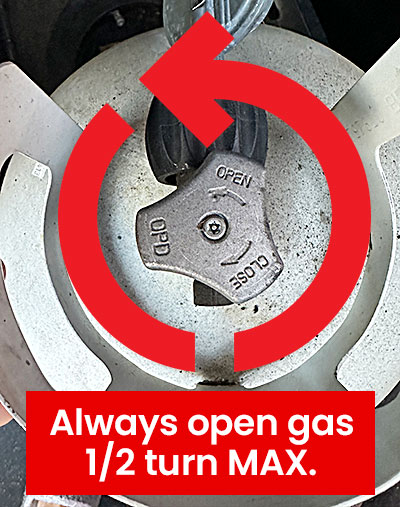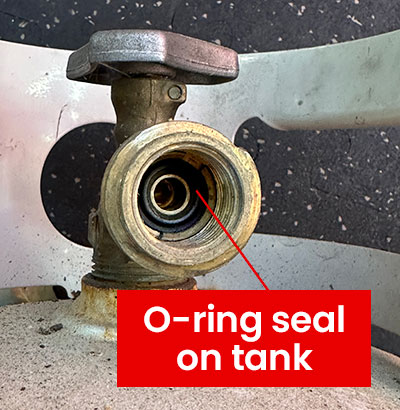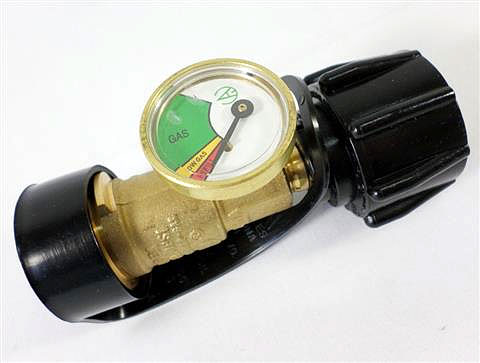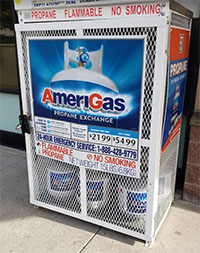Troubleshooting your Grills Gas Supply Issues
Low or Weak Flame-Bypass mode
 Problem: Since the mid 90's, regulators for propane tanks have had a federally mandated safety device which restricts the flow of gas to approx. 10% if the valve senses a higher than normal release of propane. This feature will tend to trigger into “bypass mode” if: 1, during start up if all of the gas control knobs are not fully in the off position (including the side burners!); or 2, the propane tank valve has been turned too many turns or to fully “Open”.
Problem: Since the mid 90's, regulators for propane tanks have had a federally mandated safety device which restricts the flow of gas to approx. 10% if the valve senses a higher than normal release of propane. This feature will tend to trigger into “bypass mode” if: 1, during start up if all of the gas control knobs are not fully in the off position (including the side burners!); or 2, the propane tank valve has been turned too many turns or to fully “Open”.
Solution: To reset the internal valve turn the tank valve off and disconnect the hose/regulator from the tank. Make sure all heat control knobs, including side burners are in the fully OFF position. Wait 5 minutes. Hook the grill back up and slowly open the valve on top of the tank 1/4 to 1/2 turn only. Do not open all the way! Light up your grill as you normally would.
Here’s another helpful write-up about this issue from Weber.
Regulator Adjustment
The regulator is factory set at a specified outlet pressure and is generally factory sealed and not adjustable. Do not attempt to adjust. The regulator can be checked by measuring the pressure (typically 11 inches of water column) with a manometer, which you can find at your local hardware store for around $30-50.
Valve O-ring

Before attaching the regulator to the cylinder, inspect the rubber O-ring inside the throat of the propane tank. Do not operate the grill if the O-ring is damaged or missing. Cracks, splits or distortion will allow gas to escape. Additionally, the seal should be soft, pliable, and protrude slightly from the brass.
Look for gas line damage
Critters like good barbecue too! The hose should be kept clean of grease and food drippings which attract squirrels and other animals. The animals will often eat the drippings on the hose and chew into the hose lining trying to get the last taste. Try cleaning the hose with an ammonia cleaner solution to minimize the attraction.
We suggest a stainless-steel rodent guard/hose protector. Easy install, simply slide the guard over the propane hose. Helps to prevent rodents from chewing on your propane gas hose and also protects the hose from hot surfaces on your BBQ.

Got gas? Try a Propane Fuel Level Indicator
Get a Gauge
Fresh fill? Check for Leaks
- Mix a 50/50 solution of liquid dish soap and water
- Connect the LP cylinder
- Make sure the control valves are OFF
- Brush the soap solution over the POL valve and all piping and hose connections
- Turn on the cylinder valve and listen for leaks, and look carefully for soap bubbles being formed at the connections which indicates leaks
More about LP (Liquid Propane) Tanks
Tank Age

Problem: If your tank is old, chances are that your local gas supplier will refuse to fill it. The date manufactured is stamped into the guard surrounding the cylinder valve. (This guard also acts as the carrying handle.) Cylinders should be re-certified after 12 years from this date.
Solution: Re-certification can generally be done by a local propane distributor. The charge is $10-20 and the tanks are tagged and certified for another 5 year period. Another great way to get a newer tank is to trade your old tank in at a store that offers Propane Exchange, such as Blue Rhino, Amerigas, or other.
Using Modern Tank with an Older Model Grill
You can use a new style tank with an older model standard POL fitting. The new style tank valves have internal threads which allow you to connect the standard POL fitting in a counter-clockwise rotation.
Ugly, Rusty Tanks
Even if you have the prettiest barbecue grill on the block, an ugly, unkept tank will take the whole appearance down a notch. Propane cylinders can be repainted with a rust preventative type paint. Remove loose rust with sandpaper or steel wool and clean away any grease or oils. Do not paint valve assembly and do not paint over warning labels. Mask off valve assembly and warning labels if using spray paint. Use white, or off-white paint with the color specified for propane tanks. Light colored paints will help reflect heat when exposed to the sun.